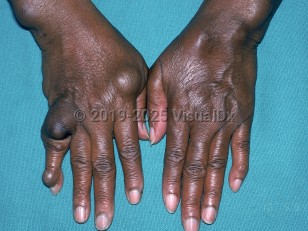Maffucci syndrome in Adult
Alerts and Notices
Important News & Links
Synopsis

Maffucci syndrome, also known as multiple enchondromatosis, is a rare congenital syndrome characterized by enchondromas and vascular malformations.
Patients develop enchondromas in early childhood that may increase in number and size until puberty. The enchondromas tend to predominate on extremities, especially in the long bones. After puberty, sequelae associated with multiple enchondromas include fractures, limb length discrepancies, and malignant degeneration. Malignant degeneration, most commonly to chondrosarcoma, occurs in up to a quarter of cases, underscoring the importance of close clinical follow-up. Patients without malignant degeneration of enchondromas have a normal life expectancy. The degree of skeletal involvement is the most important predictor of associated morbidity.
Vascular malformations are most commonly venous but can be lymphatic in origin. Spindle cell endotheliomas have also been described. These lesions develop along a similar time course as enchondromas, beginning in early childhood with progression until puberty. There is some predilection of vascular malformations to occur near enchondromas, but they can exist anywhere.
The genetic basis for Maffucci syndrome has been elucidated. Mutations in IDH1 or IDH2 can be found in more than 75% of patients with Maffucci syndrome or the related Ollier syndrome. Several additional neoplasms are described in patients with the causative IDH1 and IDH2 mutations, likely due to mosaic distribution of the mutations during embryonic development. These include acute lymphoblastic leukemia, giant tubular adenoma of the breast, granulosa cell tumor of the ovary, anaplastic astrocytoma, and other neurological osseous or parenchymal tumors.
Patients develop enchondromas in early childhood that may increase in number and size until puberty. The enchondromas tend to predominate on extremities, especially in the long bones. After puberty, sequelae associated with multiple enchondromas include fractures, limb length discrepancies, and malignant degeneration. Malignant degeneration, most commonly to chondrosarcoma, occurs in up to a quarter of cases, underscoring the importance of close clinical follow-up. Patients without malignant degeneration of enchondromas have a normal life expectancy. The degree of skeletal involvement is the most important predictor of associated morbidity.
Vascular malformations are most commonly venous but can be lymphatic in origin. Spindle cell endotheliomas have also been described. These lesions develop along a similar time course as enchondromas, beginning in early childhood with progression until puberty. There is some predilection of vascular malformations to occur near enchondromas, but they can exist anywhere.
The genetic basis for Maffucci syndrome has been elucidated. Mutations in IDH1 or IDH2 can be found in more than 75% of patients with Maffucci syndrome or the related Ollier syndrome. Several additional neoplasms are described in patients with the causative IDH1 and IDH2 mutations, likely due to mosaic distribution of the mutations during embryonic development. These include acute lymphoblastic leukemia, giant tubular adenoma of the breast, granulosa cell tumor of the ovary, anaplastic astrocytoma, and other neurological osseous or parenchymal tumors.
Codes
ICD10CM:
Q78.4 – Enchondromatosis
SNOMEDCT:
46041001 – Maffucci syndrome
Q78.4 – Enchondromatosis
SNOMEDCT:
46041001 – Maffucci syndrome
Look For
Subscription Required
Diagnostic Pearls
Subscription Required
Differential Diagnosis & Pitfalls

To perform a comparison, select diagnoses from the classic differential
Subscription Required
Best Tests
Subscription Required
Management Pearls
Subscription Required
Therapy
Subscription Required
References
Subscription Required
Last Reviewed:02/19/2020
Last Updated:01/19/2022
Last Updated:01/19/2022
Maffucci syndrome in Adult

